Just Transition Commission: background report
Background information report on the Scottish economy to help inform the early deliberations of the Just Transition Commission.
5. Household Income Distribution
Summary of Evidence: Household Income Distribution
The top ten percent of the population in Scotland had 24% more income in 2014-17 than the bottom forty percent combined. Comparing this to the two previous three-year periods suggests an increasing trend of income inequality over this period.
Real wage growth in Scotland is relatively strong over the last decade. While the UK will not return to its pre-recession peak (2008) until 2024, Scotland is currently only 1% from previous peak and is expected to match this in 2020.
Although median incomes are rising for all age groups (children, working-age adults and pensioners), for children and working-age adults they have only recently recovered to their pre-2008 recession levels
Poverty rates before housing costs in Scotland have been falling since the late nineties, but recent years' data suggest a slow increase co-inciding with the introduction of austerity after 2010. After housing costs, relative poverty rates have been rising since the all-time low in 2011-14.
In-work poverty for working-age adults has increased continuously since 2011-14, and both before and after housing costs measures were at an all-time high in 2014-17.
Forecasts of income distribution
Forecasts for the Scottish economy present a subdued outlook for the Scottish economy, driven by slow growth in GDP, productivity and wages over the last several years. This forecast is based on data which shows real wage growth has been weaker since 2010 than expected given growth in productivity and labour market conditions.
Continuing high demand for labour, an increasing proportion of older workers in the workforce and the National Living Wage alongside upward revisions to productivity are expected to feed through to real earnings growth.
The forecast shows average nominal annual earnings growth increasing from 2.0 per cent in 2018 to 3.1 per cent in 2023, broadly aligning with productivity growth. With inflation broadly flat at around two per cent, the forecast expects real wage growth to pick up from -0.3 per cent in 2018 to 1.1 per cent in 2023.
There are no forecasts for income inequality at the Scottish level. At the UK level, projections suggest income inequality in the UK is likely to increase over the five years to 2022, assuming no change in government policy.
This increase in income inequality is due to real earnings growth mainly benefiting higher income households and a reduction in the real value of working age benefits.
Including housing costs has the effect of further depressing real income growth for the lowest-income households. Housing costs are expected to increase for these households as a consequence of rising rents.
Turning to income after housing costs, projections show a sharper increase in income inequality up to 2021/22 reflecting contrasting trends in housing costs for different groups with the P90/P10 ratio will rise from 5.1 in 2015/16 to 5.9 by 2021/22. This would be the highest ratio since comparable records began in 1961.
Policy Context
5.1. Narrowing income inequalities is a key objective of the Scottish Government as set out in the 2015 Economic Strategy: "creating a fairer society is not just a desirable goal in itself, but is essential to the sustained, long-term prosperity of the Scottish economy"[39]. The strategy identifies four actions to promote inclusive growth:
- Fair Work: Promote Fair Work and build a labour market that provides sustainable and well-paid jobs;
- Business pledge: Address long-standing barriers in the labour market so that everyone has the opportunity to fulfil their potential;
- Promoting equality and tackling inequality: Tackle cross-generational inequality through, for example, improved child care, boosting attainment and early years interventions that give every child a fair start in life; and
- Place and regional cohesion: Realise opportunities across Scotland's cities, towns and rural areas, capitalising upon local knowledge and resources to deliver more equal growth across the country.
5.2. Scotland's National Performance Framework (NPF) underpins delivery of the Scottish Government's priorities and monitors the delivery of the Scottish Government's purpose. This includes a Solidarity target[40]:
- To increase the total income (adjusted for inflation) of all households in Scotland;
- and to reduce income inequality by decreasing the ratio of income to the top 10% of households compared to the bottom 40% (i.e. the Palma ratio).
The Evidence Base: Current Position
5.3. Poverty and income inequality in Scotland: 2014-2017[41] estimates the number and proportion of people living in poverty in Scotland in 2014 to 2017. This publication presents three-year averaged estimates of the percentage of people, children, working age adults and pensioners living in low income households in Scotland, and other statistics on household income and income inequality. The estimates are used to monitor progress in reducing poverty and income inequality.
Income inequality fell following the 2008 recession but has risen since
5.4. This measure of how equally income is distributed across the population is known as the "Palma ratio" or "S90/S40 ratio"[42]. Figure 5.1 shows the ratio of total income received by the top ten percent of the population divided by the total income of the bottom forty percent of the population (expressed as a percentage) over time.
Figure 5.1: Income inequality
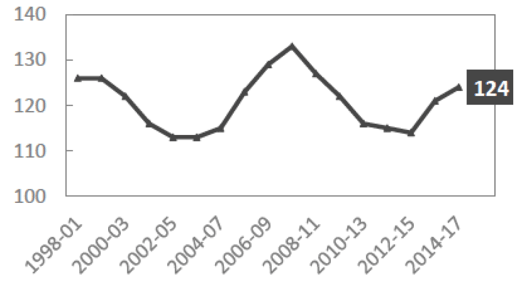
Source: Poverty and income inequality in Scotland: 2014-2017
5.5. The Palma ratio is used internationally to estimate the extent of inequality between those at the top of the income distribution and those at the bottom and is currently used in Scotland to monitor progress towards the Scottish Government's Solidarity Purpose Target. The top ten percent of the population had 24% more income in 2014-17 than the bottom forty percent combined. Comparing this to the two previous three-year periods suggests an increasing trend of income inequality over this period.
Overall household income is rising but unevenly across demographic groups
5.6. In 2014-17, median household income before housing costs was £485 per week, compared to £475 in 2013-16. Median income has increased steadily since the last recession and has reached its highest level since reporting began. Median income after housing costs has followed the same trend to median income before household costs. Median income after housing costs was £432 per week in 2014-17, at its highest level since reporting began.
Figure 5.2: Median household income, 2016/17 prices
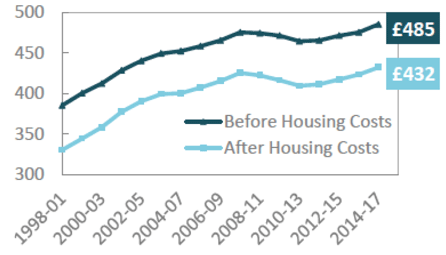
Source: Poverty and income inequality in Scotland: 2014-2017
5.7. Although median incomes are rising for all age groups (children, working-age adults and pensioners), for children and working-age adults they have only recently recovered to their pre-2018 recession levels (figure 5.3).
Figure 5.3: Median household income after housing costs by demographic group, 2016/17 prices
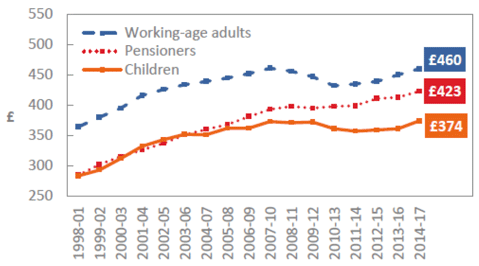
Source: Poverty and income inequality in Scotland: 2014-2017
5.8. Analysis of real wage growth over the last decade suggests that compared to elsewhere in the UK, Scotland has done relatively well (Figure 5.4). While the UK will not return to its pre-recession peak (2008) until 2024, Scotland is currently only 1% from previous peak and is expected to match this in 2020.
Figure 5.4: Percentage growth in median weekly earnings, 1998-2017
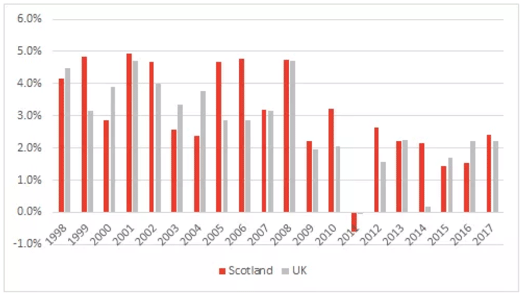
Source: Fraser of Allander Institute (2017) How are Scottish earnings performing relative to the UK[43]
Relative poverty rates fell until the 2008 recession but have risen since
5.9. Relative poverty is a measure of whether the income of the poorest households are keeping pace with middle income households across the UK. It is estimated that 16% of Scotland's population, or 860,000 people each year, were living in relative poverty before housing costs in 2014-17. This compares to 15% in the previous period. After housing costs, 19% of Scotland's population, or 1 million people each year, were living in poverty in 2014-17, the same as in 2013-16 (Figure 5.5).
5.10. Poverty rates before housing costs in Scotland have been falling since the late nineties, but recent years' data suggest a slow increase co-inciding with the introduction of austerity public sector budgets after 2010. After housing costs, relative poverty rates have been rising since the all-time low in 2011-14.
Figure 5.5: % of people living in relative poverty
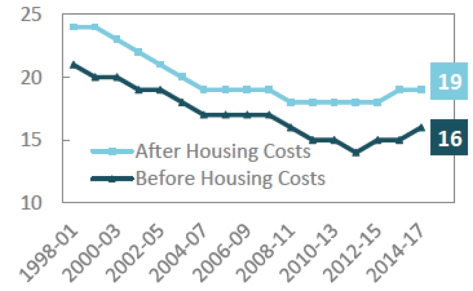
Source: Poverty and income inequality in Scotland: 2014-2017
In-work poverty has increased significantly since the 2008 recession
5.11. In 2014-17, 58% of working-age adults in relative poverty before housing costs were living in working households (Figure 5.6). After housing costs, this was 59% of working-age adults. In-work poverty for working-age adults has increased continuously since 2011-14, and both, before and after housing costs measures were at an all-time high in 2014-17.
Figure 5.6: Percentage of working age adults in in-work poverty[44]
![Figure 5.6: Percentage of working age adults in in-work poverty[44] Figure 5.6: Percentage of working age adults in in-work poverty[44]](/binaries/content/gallery/publications/publication/2019/04/transition-commission-background-report/SCT03199357601_g36.gif)
Forecast Projections
Low nominal and real forecasts for wage growth from 2018 to 2023
5.12. The Scottish Fiscal Commission[45] presents a subdued outlook for the Scottish economy, driven by slow growth in GDP, productivity and wages over the last several years. The forecast is based on data which shows real wage growth has been weaker since 2010 than expected given growth in productivity and labour market conditions. The residual category captures a number of factors that could have been acting as a drag on wage growth, which include:
- Ongoing uncertainty and low confidence in the economy
- Rising non-wage labour costs and limited business profitability
- Changes in the oil & gas industry following the fall in oil prices from2014 onwards and declining UKCS expenditure
- Downward pressure on wages from the increasing trend towards automation and artificial intelligence technologies in business processes
- A rise in low-paid 'gig-economy' work
Figure 5.7: Contributions to real wage growth, outturn and forecast (per cent)
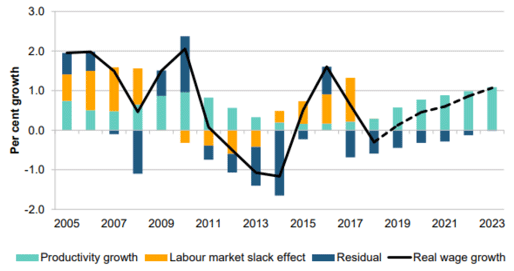
5.13. Looking ahead, the SFC expects the overall drag on wage growth relative to productivity to lessen, by the shrinking of the residual category from 2018 onwards, allowing wage growth to increase. This more positive outlook for wage growth relative to the last eight years is driven by:
- Ongoing tightness in the labour market starting to feed through to higher wage growth.
- Higher public sector pay in Scotland having a direct effect on the pay of those in scope in the public sector, as well as indirect spillover effects on the pay of those in the private sector.
- The National Living Wage is set to increase by 4.4 per cent in 2018,increasing wages for some of those in employment on lower incomes.
- Demographic change means that the labour market will see a shift from younger workers to older workers. Forecasts suggest that between 2010 and 2025, there will be 120,000 fewer individuals aged 16-24, and 280,000 more individuals aged over 55 in the labour market. On average, those in their 50s earn around 40 per cent more than those in their 20s. This shift in the labour market is expected to increase average earnings over the next five years.
- Increases in productivity are expected to feed through to real earnings growth.
5.14. The forecast shows average nominal annual earnings growth increasing from 2.0 per cent in 2018 to 3.1 per cent in 2023, broadly aligning with productivity growth. With inflation broadly flat at around two per cent, the forecast expects real wage growth to pick up from -0.3 per cent in 2018 to 1.1 per cent in 2023.
Decoupling of productivity and wage growth
5.15. At the UK level, wages have been increasingly decoupled from productivity (Figure 5.8)[46]. This has implications for the interpretations of wage forecasts that are based on continued improvements in productivity. There are two dimensions to this:
- The gap between average wages and total compensation per hour suggests that non-wage labour costs, mostly pensions, have taken a growing share of the productivity growth that has been achieved.
- The opening of the gap between mean and median wages is because of rising wage inequality. As top earners had faster wage growth that pulled the average (mean) wages up at a faster rate than the median wages (of the middle or typical worker).
Figure 5.8: Decoupling of wages from productivity, UK
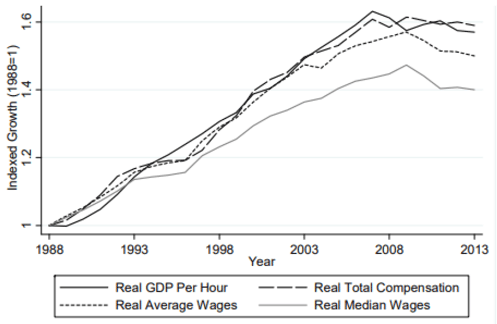
Source: Machin, S (2015) Real Wage Trends. Understanding the Great Recession: From Micro to Macro Conference, Bank of England, September 23 and 24 2015
Forecasts for income inequality show an increase in inequality due to real earnings growth mainly benefiting higher income households and a reduction in the real value of working age benefits
5.16. There are no forecasts for income inequality at the Scottish level. At the UK level, projections by the Institute for Fiscal Studies (IFS)[47] and the Resolution Foundation[48] suggest income inequality in the UK is likely to increase over the five years to 2022, assuming no change in government policy[49].
5.17. Looking first at income before housing costs, growth in inequality between 2015/16 and 2021/22 is expect to reverse the fall in inequality observed after the economic downturn in 2008. The IFS projects that the P90/P10 or Gini ratio will rise from 3.9 in 2015/16 to 4.4 in 2021/22, similar to its level at the start of the 1990s[50].
5.18. Turning to income after housing costs, the projections show a sharper increase in income inequality up to 2021/22 reflecting contrasting trends in housing costs for different groups. The IFS projects that the P90/P10 ratio will rise from 5.1 in 2015/16 to 5.9 by 2021/22. This would be the highest ratio since comparable records began in 1961, the ratio previously having peaked at 5.4 in 2008/09 and 2009/10.
5.19. The Resolution Foundation has also produced projections for the Gini coefficient. This is expected to increase from just under 35% in 2015/16 to around 36% by 2022/23 based on incomes before housing costs. On an after housing costs basis, it is expected to increase from 39% in 2015/16 to around 40% by 2022/23. However, the Gini coefficient is more sensitive to changes in income at the very top and bottom of the income distribution than the Palma ratio and so make the projections less robust.
5.20. The projected increase in inequality in incomes before housing costs is attributable to two main factors:
- Firstly, forecast growth in real earnings is expected to mostly benefit higher-income households, since earnings make up a larger share of total income for these household.
- Secondly, cuts in the real value of working-age benefits are expected to reduce the real incomes of poorer households.
5.21. Including housing costs has the effect of further depressing real income growth for the lowest-income households. Housing costs are expected to increase for these households as a consequence of rising rents. The IFS observes that rising rents can be expected to have a greater impact on these households than has previously been the case because of the cash terms freeze in local housing allowances until 2020. The freeze means that for more low-income households in the private rented sector, housing benefit awards will not full cover the cost of their rent. Combining these effects with planned benefit cuts, the IFS estimates that the income of a household at the 10th percentile of the distribution will decrease by 7% between 2015/16 and 2021/22, after adjusting for inflation.
5.22. Mortgage interest payments are also expected to increase above inflation over this period, albeit from a low base. This will lead to an increase in housing costs for some households further up the income scale, although income growth after housing costs is still projected to be weakest for households at the bottom.
5.23. The Resolution Foundation estimates that real incomes will fall for the lowest-income households in each year between 2016/17 and 2019/20. However, while stronger growth is projected for households near the top of the income distribution, their projected rate of income growth of around 2% per year by the early 2020s is still "mediocre by historical standards. No part of the distribution is forecast to have growth higher than its 1994-95 to 2007-08 average". This makes the outlook for the coming years highly unusual, in that rising inequality occurs alongside weak growth in real incomes. By contrast, the rise in inequality during the 1980s occurred alongside very strong income growth for households in the top half of the income distribution and moderate income growth for households in the bottom half.
Contact
Email: Gregor.Auld@gov.scot
There is a problem
Thanks for your feedback